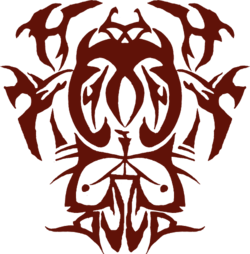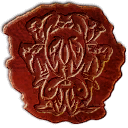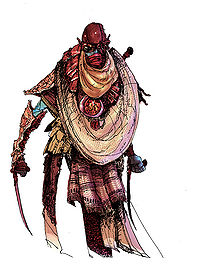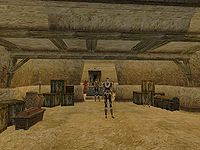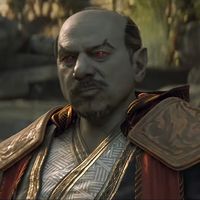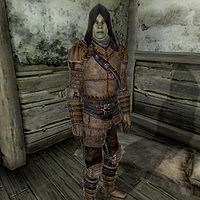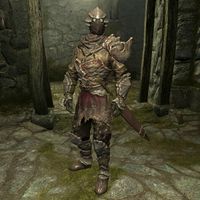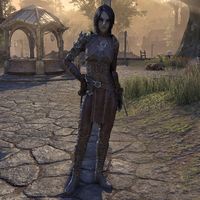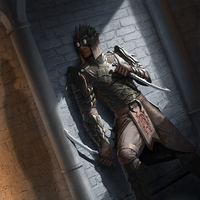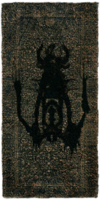Lore:Morag Tong
Morag Tong (Dark Elvish for "Foresters Guild")[1] is an ancient guild of assassins headquartered in Morrowind, celebrating murder in the name of Mephala. They have been active since at least the First Era, and their targets have included multiple rulers of Tamriel, high-ranking Dunmer nobility, and countless others. The Morag Tong is unique in its sanctioned status under the Morrowind government to perform legal executions, bound under contracts called 'writs', although extralegal 'gray writs' are rumored to exist.
The Great Houses of Morrowind often used the Morag Tong to eliminate their rivals, a preferred alternative to open conflict.
Contents
History[edit]
Prominent Years[edit]
The origins of the Morag Tong are shrouded in myth. The orthodoxy of the Tribunal hold that the Daedra Mephala founded the guild to teach the early Chimer how to defend themselves and destroy their adversaries.[2] Hermaeus Mora is tangentially related to the origins of the Tong by association with his sibling, Mephala.[1] Others state it began as a cult which, while also following Mephala, ultimately revered the 'Dread Father' Sithis above all.[3] However it began, the guild quickly rose to prominence in the environment of early Morrowind's bloody House conflicts, quickly establishing the writ system and a reputation as peerless killers. At the end of the First Era, the Tong received its highest-profile contract to date, on Emperor Reman III.[3] Their success paved the way for the Akaviri Potentate to rule over Tamriel in the early parts of the Second Era, as the Tong slowly expanded its presence across Tamriel. It came full circle when, in 2E 324, Versidue-Shaie was assassinated by the Tong. By this point, however, the guild was over-confident and prideful, and 'MORAG TONG' was scrawled on the palace walls in the Potentate's own blood.[4] Certain Dunmeri scholars deemed elements of this narrative dubious.[5]
This high-profile assassination started a frenzy among the nobles of Tamriel who realized that they too were at risk from the Tong. "Every sovereign gave the cult's elimination his highest priority",[4] and it was viciously suppressed in every province of the Empire, only retaining the barest presence in its homeland of Morrowind. After this, the Morag Tong sunk out of public sight for almost a century. It is during this time that most agree the Dark Brotherhood arose as a splinter group, establishing itself mostly outside of Morrowind as a more business-oriented guild operating entirely beyond the law.[3]
Fall from Prominence[edit]
While the Dark Brotherhood rose to greater prominence elsewhere, the Morag Tong maintained a formidable presence in Morrowind. Accounts suggest they gave up the worship of Mephala in exchange for revering the god-king Vivec, though they maintained their worship of Sithis.[3] Despite the common service to Sithis, they were mortal enemies of their old splinter group, the Dark Brotherhood, who revered the Night Mother. The Tong maintained its traditional original position of the First Era: that of an impartial middle-man in the conflicts between the Great Houses in the bloody business of Dunmeri politics. Some within the faction, however, felt that their services were undervalued as rich nobles with petty grievances used the Tong too freely, not respecting the ancient institution; however, they did not act outside of Morrowind, nor did they interfere in politics higher than that of inter-House rivalry. Nor did they apparently act on their own account, except against the Dark Brotherhood or worshippers of Mehrunes Dagon. Indeed, sometimes they were hired to track down and kill outlaws, as an alternative to the more traditional Fighters Guild bounty.[6]
The Seven Secretives and the Simulacrum Rubric[edit]
The Dunmer Rythe Verano was one of the last of the Morag Tong members who were around before the Potentate assassinations that sent their guild into decline. He worked for centuries at restoring the reputation of the Morag Tong with the Great Houses, getting them to once again accept the Tong as a legitimate organization.[7] By 2E 582, the Tong had started to gain great footing and Verano had become the Grandmaster. He was not satisfied with these accomplishments, and would be one of the people who would plot a coup of the current Tong. The group created a list of goals, which if achieved, would transform the Tong into more than a mere league of assassins: it would make them powerful enough to allow them to replace the heads of state that were once able to force them to go into hiding. The plot was known as the Simulacrum Rubric, named after one of the items they sought to obtain, Sotha Sil's Simulacrum Rubric. It was orchestrated by Verano and seven other influential members of the Tong who called themselves the Seven Secretives.
The Morag Tong assassin Naryu Virian sought an audience with the Tribunal god Vivec, to be granted a Tribunal sanction for extrajudicial execution for her superior, Rythe Verano. She had discovered that Verano was involved with the Secretives' plot, and had ordered writs of execution for the remaining members of the group to throw her off his trail. Vivec granted her request and provided with her an ally, a warden by the name of Boldekh, who wanted to bring Verano to justice for his involvement in the death of his partner. They tracked him to Sadrith Mora, where they spotted a Telvanni mage teleporting him to the Clockwork City through a portal which vanished along with Verano. They convinced the mage to give them passage to the Clockwork City, and once there, they tracked Verano into a mechanist's workshop where he obtained one of the items needed—Sotha Sil's Simulacrum Rubric. He spotted them, panicked, and summoned a portal back to Vvardenfell. Naryu and Boldekh followed him through it and emerged in Mudan Ruins. Argonian guards were waiting for him there but fled when an army of Dwemer Animunculi appeared out of the ruin. A Dwarven colossus appeared out of the ruin, blasting it apart and immolating Verano along with the satchel that held the Simulacrum Rubric. The combined efforts of Naryu and Boldekh destroyed the colossus. Naryu severed the grandmaster's head and took his skull as a trophy to take with her as she sought to carry out the writs of execution on the remaining traitors.[8]
The journey led Naryu all across Tamriel, where she would successfully carry out her executions. Various fates occurred to the contributions each target brought to the plot. The first required the hiring of a smuggler that was able to enter the Clockwork City to steal a second Clockwork artifact. Its importance led Clockwork Apostles to chase the smuggler back to Nirn when it was taken from them. The Clockwork artifact was destroyed when the target got into a brawl with the smuggler.[9]
The second was an alchemical secret that was sought in Craglorn. It consisted of combining forbidden reagents with stolen Celestial power. The result would be the creation of monsters said to be able to revert Tamriel back to the chaos of the Dawn Era. The potion that held the alchemical secret was destroyed.[7] The third contribution was sought in the Imperial City, where the target sought to learn secrets of daedric summoning in the daedra-occupied city. The various secrets of daedric summoning were lost with the death of the third target.[10]
The fourth contribution brought Naryu to Wrothgar, where it was revealed that the contribution was eight scrolls for summoning pariah scamps, which when consumed, make mortals unnoticeable. The scrolls were recovered by her and were used to make convenient getaways.[11]
The fifth contribution was the Helm of Oreyn Bearclaw, located in Orsinium, which grants the wearer divine dexterity and enhanced endurance. It was returned to Gadnuth Oreyn, a descendant of the original owner of the helmet.[12]
The sixth contribution brought Naryu to Hew's Bane, where the contribution was revealed to be the Yokudan artifact known as the Aurbical Abacus. It could not only predict the weather but actually influence it on a continental scale. Naryu destroyed the Abacus after the sixth target was eliminated.[13]
The seventh contribution was to negotiate the formation of an alliance with the rival assassin's guild, the Dark Brotherhood, via a hostile takeover if necessary, in order to spread the Tong's influence across the entire continent. The Brotherhood rejected the offer, and an alliance with the Order of the Hour was made instead. It was severed when Naryu completed her last writ of execution, destroying the dream of the Simulacrum Rubric, and bringing honor back to the Morag Tong with the deaths of the Seven Secretives.[14]
Post-Red Year[edit]
After the Argonian invasion and devastation of Vvardenfell, the Tong dispersed, though the remaining members hoped to reunite some day,[15] which they did sometime prior to 4E 201.[16] Even though the devastated factions within Vvardenfell were gone, the Morag Tong still had a presence on the mainland of Morrowind and even took contracts on Solstheim. They were hired by Vendil Ulen for use in his plot to assassinate Councilor Lleril Morvayn, as an act of revenge for the execution Morvayn ordered on a member of the Ulen family years before.[17] They also had run-ins with their rivals, the Dark Brotherhood, sanctioning writs of execution in an effort to terminate their members.[18]
Organization[edit]
Ultimately, the Morag Tong pledges itself to the service of Mephala, Daedric Prince of lies, deception, and murder. In Morrowind, the guild is led by a Grandmaster, who traditionally serves for life until killed in the line of duty. Each guild hall is run by a Master, who has a high level of autonomy with regards to accepting writs and issuing assignments. Individual members, however, cannot accept writs without the approval of the Tong, or else they face punishment.
The Morag Tong fills a vital role in Dunmeri politics by preventing all-out war between the Great Houses. Rather, they follow Mephala's advice to "kill them with secret murder"[2] by employing Tong assassins in targeted strikes to accomplish political goals. To facilitate this, the Tong maintain a strict policy of impartiality, accepting any job provided it is proposed in the correct manner and with the proper payment. Because of its official sanction, the guild has the authority to print legal bills known as Honorable Writs of Execution, which excuse a Tong agent of all legal misgiving associated with any Tong related business. As such, Morag Tong executioners are expected to give themselves up immediately following an execution even if the death itself would have remained a mystery, in order to legally absolve themselves and avert any possible long-term ramifications. Tong executioners who fail to do so are considered suspect by their order and may be subject to major internal investigations, as the Tong does not harbor criminals.[19]
The most famous assassins who cannot continue their duty are sent to Vounoura, an island which is not more than a month's voyage by boat from Tel Aruhn.[20]
The armaments of the Morag Tong are meticulously crafted to embody both lethality and intimidation. Axes wielded by members of this ancient guild feature broad crescent blades with double-bite inset edges. Belts, resembling those of wood hunters, are fashioned from stout leather occasionally adorned with dreugh or mudcrab chitin. Boots are designed for stealth, with chitin toe and upper protection combined with flexible leather soles, ensuring silent approach to targets. Bows, constructed from hardwood and horn, bear metallic parry-crescents and spider-web supports, paying homage to Mephala. The Morag Tong's signature cuirasses strike fear with dark leather and irregular chitin plates, evoking a monstrous, crustacean-like appearance. Daggers feature offset demi-crescent blades with hooks for corpse handling, emphasizing the guild's ruthless efficiency. Gauntlets, essential for delicate tasks like lock-picking and garroting, must feature half-finger coverage, allowing operatives full dexterity while maintaining protection. Similarly, helmets, vital for concealment and protection, require flawless visor construction to prevent vision distortion, ensuring strikes land precisely where intended. Leg greaves, crafted from sturdy leather and chitin, eschew bone for authenticity, with poleyns angled to the side for added menace. Maces, following traditional Chimer warhammer designs, emphasize functionality over flashiness, sheathed below the head for optimal parrying. Shields, though appearing chitinous, consist of ashwood veneered with metal for thematic unity with the Tong's armor. Shoulders, crucial for maintaining the Tong's distinctive silhouette, feature layered chitin plates with curved spikes for intimidation. Spell staves are tailored for the select few spellcasters among their ranks. While the exact origins of their design remain shrouded, adherence to tradition is paramount to ensure operational effectiveness. Swords are adorned with irregular curved points along the spine, and are crafted to serve dual purposes. With a single sharp edge curving towards a pointed back-barb akin to daggers, these swords are designed for efficiency in dispatching foes and retrieving corpses.[21] They were known for their shortblades, light armor and marksmanship.[22]
Gallery[edit]
Rythe Verano, Grandmaster of the Tong, circa 2E 582 (ESO)
Eno Hlaalu, Grandmaster of the Tong circa 3E 427 (Morrowind)
See Also[edit]
- For game-specific information, see the Morrowind, SkyrimDB, and Elder Scrolls Online articles.
References[edit]
- ^ a b Varieties of Faith... — Brother Mikhael Karkuxor of the Imperial College
- ^ a b The Anticipations — Anonymous
- ^ a b c d Fire and Darkness — Ynir Gorming
- ^ a b The Brothers of Darkness — Pellarne Assi
- ^ Bildren Saren's dialogue in ESO: Dragonhold
- ^ Events of Morrowind - writs for Bemis and Llarys
- ^ a b Naryu's Journal/Craglorn — Naryu Virian
- ^ Naryu's Journal/Vvardenfell, Before — Naryu Virian
- ^ Naryu's Journal/Vvardenfell — Naryu Virian
- ^ Naryu's Journal/Imperial City — Naryu Virian
- ^ Naryu's Journal/Wrothgar — Naryu Virian
- ^ Naryu's Journal/Orsinium — Naryu Virian
- ^ Naryu's Journal/Hew's Bane — Naryu Virian
- ^ Naryu's Journal/Gold Coast — Naryu Virian
- ^ Ravyn Imyan's dialogue in Skyrim
- ^ Events of Served Cold in Skyrim:Dragonborn
- ^ The Ulen Matter — Vendil Ulen
- ^ Writ of Execution:
- ^ Honorable Writs of Execution — Enar Dren
- ^ 2920, Evening Star — Carlovac Townway
- ^ Crafting Motif 30: Morag Tong Style — Naryu Virian
- ^ The Black Glove
Note: The following references are considered to be unofficial sources. They are included to round off this article and may not be authoritative or conclusive.
| ||||||||||||||
| |||||||||||||||||
| |||||||||||||||||||||||||||||
